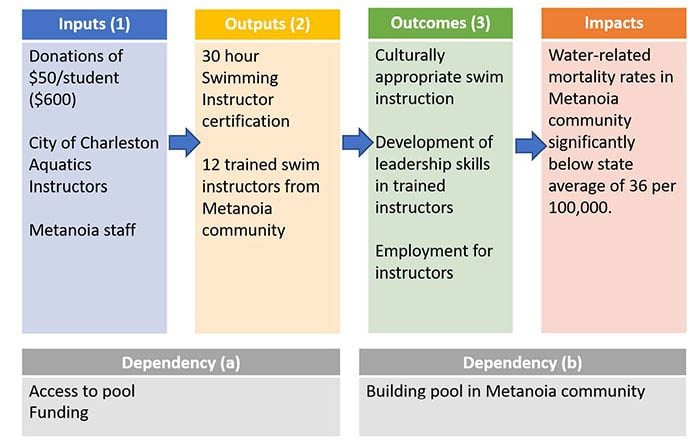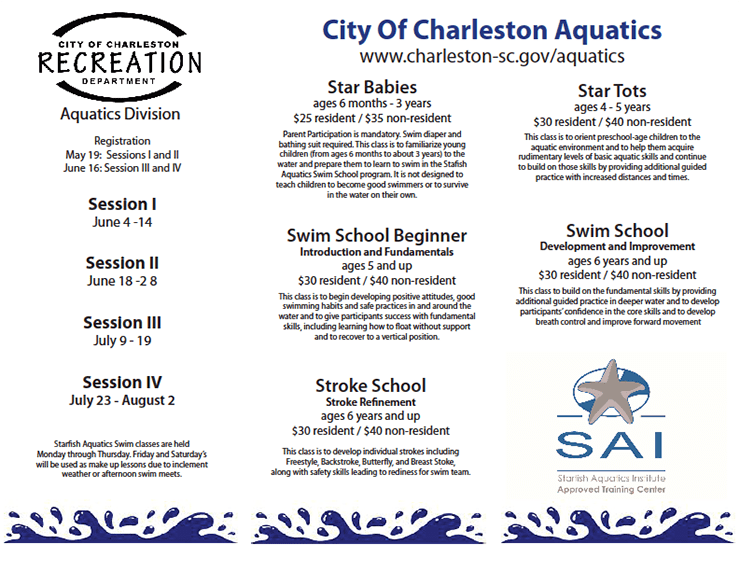Background
Children ages 1 – 4 have the highest likelihood of drowning across the US generally and in SC (CDC, 2018; CDC, 2016; CSN, 2015). Of all major injuries and deaths among children, drowning was tied with homicide as the number one cause of death in South Carolina1 children ages 1-4 at 36 of every 100,000 children (CSN 2015). Additionally, it is the number three cause of death among South Carolina children ages 5 – 14 at between 15 and 24 per 100,000, and the number five cause of death among children ages 15 – 19 at 38 per 100,000. Deaths tend to be higher in coastal communities – a phenomenon that is not confined just to the US. A number of US and international studies have shown that drowning prevalence is higher in coastal communities (Morgan, Smith, & Triggs, 2008; Franklin, Scarr & Pearn, 2010; Brenner et al, 2001).
Across all age groups, minority children are 5.5 times more likely to die of drowning than White non-Hispanic children (Gilchrist & Parker, 2014). This disparity is largest in 11-12 year old children at 10 times that of White non-Hispanic children (Gilchrist & Parker, 2014). Note that these figures are likely underestimated given lack of sufficient data on the numbers of minority children who participate in water-based activities. Branche et al (2004) show that the estimation is biased towards the lower end of the spectrum since the figures are based on the percentage of each subgroup within the population as opposed to the percent who participated in water-related activities, e.g. if the figure were based on the proportion of the population participating in water-based activities as opposed to population the disparity between minorities and Whites would be even larger.
A lack of swimming ability is identified as the number one cause of drowning in minority children (Irwin, Irwin, & Ryan, 2009). This lack of swimming ability is largely determined by culture and history of segregation in water-based activities, with African American youth and parents displaying both a higher fear of drowning and significantly less access to swimming facilities and water-based activities than their White non-Hispanic peers (Irwin, Irwin & Ryan 2011). In terms of other risk factors, day of the week and socioeconomic status predict higher rates of drowning with more drownings and near drownings occurring on week days when there is less parent or caretaker supervision (Shenoi et al, 2016) and with individuals of lower socioeconomic status drowning at higher rates than those at median income or above (Birken 2004).
As to prevention, swimming lessons in conjunction with increased confidence around the water has show significant decreases in drowning deaths in minority children (Brenner et al, 2009). The lack of available resources for lower SES and minority children though places them at a distinct disadvantage for taking advantage of these lessons (Golob, Giles, & Rich, 2013). While studies have called for increasing access to swimming lessons as a means of curbing drowning deaths among minorities, the successes of these programs has been limited due to messaging and appropriate cultural communication (Tawfeeg, Anderson, & Ramos, 2018). To this end, Tawfeeg, Anderson and Ramos (2018) and Glassman et al (2018) recommend community collaboratives in addition to multi-channel messaging (brochure, email, text, social media and window clings) as an approach to increasing uptake of swimming lessons among minorities and low SES children and families.
1South Carolina children are used rather than Tri-County children due to privacy protections for incidence below 9:100,000 per county.
SWIM Intervention
SWIM will partner with Metanoia and Outdoor Afro to provide culturally competent swimming instruction in the Metanoia service area (Chicora neighborhood in North Charleston, SC). The intent is to train an initial cohort of 12 students in Metanoia, aged 16+, as instructors who will then provide water safety instruction to other students at Metanoia. It is important that the student-instructors come from the Metanoia service area in order to address issues of trust and cultural competence2. For example, the issues of how water affects African American hair is one that, if understood by White non-Hispanic instructors, is more easily conveyed by an individual who the students see as having a similar demographic identity.
The process will begin with identification of Metanoia students who would be willing to serve as instructors. These students will be interviewed and vetted by Metanoia staff to ensure they are mature enough to take on the responsibilities of leading other students in water safety. No prior swimming abilities will be necessary. Training will be provided by the City of Charleston Recreation Department.
The City of Charleston Recreation Department’s Starfish (Swim School Beginner) program has agreed to provide instruction to the initial the student-instructors3. Upon successful review of aquatic and instructional skills, the City of Charleston Recreation Department has stated that they would hire these individuals to serve as instructors. Their instructional responsibilities would be split between traditional instruction and specific instruction of the Metanoia students.
2The logic model for SWIM is available in the Appendix.
3A brochure for Starfish is included in the Appendix.
Intended Outcomes
Given the needs described herein and the empirically validated role of culturally competent instruction in providing swimming skills to minority communities. The intended outcomes of this program are two-fold:
- To provide a system within Metanoia to provide culturally competent swim (Starfish Beginner) instructors to service students in the Metanoia community.
- To ensure the students trained under the SWIM framework have the requisite water safety skills to prevent drowning in a traditional pool environment. a. Drowning deaths for this population will be below the current rate of 36 per 100,000.
- To provide leadership and employment opportunities to the student-instructors trained within the SWIM program.
References
Birken, C. & MacArthur, C. (2004). Socioeconomic status and injury risk in children. Pediatrics Child Health 9: 323-325.
Brenner, R.A., Trumble, A.C., Smith, G.S., Kessler, E.P., Overpeck , M.D. (2001). Where children drown, United States, 1995. Pediatrics, 108: 85-89.
Brenner RA, Taneja GS, Haynie DL, Trumble AC, Qian C, Klinger RM, Klevanoff MA. (2009). Association between swimming lessons and drowning in childhood: A case-control study. Archives of Pediatrics & Adolescent Medicine, 163: 203-210
CDC, National Center for Injury Prevention and Control (2018). Web-based Injury Statistics Query and Reporting System (WISQARS) [online]. Available from: URL: http://www.cdc.gov/injury/wisqars.
CDC. (2016). Wide-ranging online data for epidemiologic research (WONDER). Atlanta, GA:
CDC, National Center for Health Statistics; 2016. Available at http://wonder.cdc.gov.
Children’s Safety Network, National Injury and Violence Prevention Resource Center. 2015 South Carolina State Fact Sheet. Available at: https://www.childrenssafetynetwork.org/sites/childrenssafetynetwork.org/files/South%20Carolina%202015%20State%20Fact%20Sheet.pdf
Franklin, R.C., Scarr, J.P., Pearn, J.H. (2010). Reducing drowning deaths: the continued challenge of immersion fatalities in Australia. Medical Journal of Australia 192: 123-126.
Galssman, T.J., Castor, T., Karmakar, M., Blavos, A., Dagenhard, P., Domigan, J., Sweeney, E., Diehr, A., & Kucharewski, R. (2017). A social marketing intervention to prevent drowning among inner-city youth. Health Promotion Practice 19: 175-183.
Gilchrist J. & Parker EM. (2014) Racial/ethnic disparities in fatal unintentional drowning among persons aged ≤29 years—United States, 1999–2010. Morbidity and Mortality Weekly Report 63: 421-426
Golob, M.I., Giles, A.R., & Rich, K.M. (2013). Enhancing the relevance and effectiveness of water safety education for ethnic and racial minorities. International Journal of Aquatic Research and Education 7: doi: 10.25035/ijare.07.01.05
Irwin CC, Irwin RL, Ryan TD. (2009). Urban minority youth swimming (in)ability in the United States and associated demographic characteristics: toward a drowning prevention plan. Injury Prevention, 15: 234-239.
Irwin CC, Irwin RL, Ryan TD. (2014). The legacy of fear: Is fear impacting fatal and non-fatal drowning in African American children? Journal of Black Studies, 42: 561-576.
Morgan, D., Smith, J.O., & Triggs, T. (2009). Self-reported water and drowning risk exposure at surf beaches. Australian and New Zealand Journal of Public Health 33: 180-188.
Tawfeeg, A.K.B., Anderson, A., & Ramos, W.D. (2018). A cause to action: Learning to develop a culturally responsive/relevant approach to 21st century water safety messaging through collaborative partnerships. International Journal of Aquatic Research and Education 11: doi: 10.25035/ijare.11.01.08
Appendix
Figure A1. SWIM Logic Model

Figure A2. Starfish Brochure

